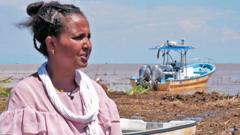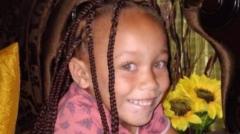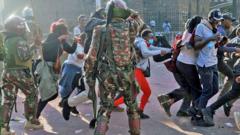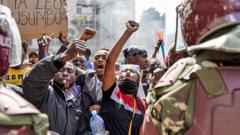As families seek asylum and safety from tumultuous conditions in Eritrea, the tragic story of 14-year-old Hiyab Mebrehtu reveals the dangers of human trafficking across Lake Turkana. With increasing reports of tragedies at sea, a grieving mother calls for awareness and accountability among smugglers.
Grieving Mother Exposes Smugglers After Daughter’s Tragic Drowning in Lake Turkana

Grieving Mother Exposes Smugglers After Daughter’s Tragic Drowning in Lake Turkana
Senait Mebrehtu mourns her daughter who drowned while crossing into Kenya, blaming smugglers for the perilous journey.
As the sun set over Lake Turkana, Senait Mebrehtu sat solemnly on its western shore, throwing flowers into the water in memory of her 14-year-old daughter, Hiyab, who drowned while attempting to reach Kenya. Hiyab’s journey, alongside her elder sister who survived, was marked by the dangers associated with human smuggling along an emerging new route that traffickers exploit to navigate border controls.
Ms. Senait, a Pentecostal Christian from Eritrea who fled her homeland to escape religious persecution, recounted how Hiyab and her sister were lured into a perilous adventure by terrorists steeped in deception. Upon her arrival in Nairobi three years earlier, she found herself unable to bring her elder daughters due to the looming threat of conscription in Eritrea, where military service is often indefinite and harsh.
Desperate to reunite her family, Ms. Senait relied on smugglers to transport her daughters from Eritrea through Ethiopia and eventually to the shores of Lake Turkana. "Had the smugglers divulged the dangers of such a significant and treacherous lake, I would never have permitted my daughters to embark on this journey," Ms. Senait emphasized, gripped by sorrow.
A local smuggler operating on Lake Turkana revealed to the BBC that this route has become increasingly popular for such crossings. Citing a new trend they call the "digital route," smugglers have adapted their operations in response to heightened security measures by Kenyan authorities on traditional land routes.
With one smuggler admitting to a rate of $1,500 per migrant, four times the average Kenyan salary, she reflected on the moral quandaries of her occupation. "As a mother, witnessing the plight of other women’s children weighs heavily on my heart," she said, urging families to rethink sending children on such dangerous voyages.
Eyewitness accounts from fellow migrants recount the horrific moments when Hiyab’s boat capsized, resulting in a tragic loss of life. Reports indicate that inadequate vessel capacities, heavy loads, and negligent smugglers contribute significantly to the casualties emerging from these crossings.
The UNHCR has documented that there are currently over 345,000 Eritrean refugees in East Africa, as increasing numbers seek sanctuary from conscription and political unrest. As families scrape together financial resources for smuggler services, they are often misled, further complicating their already precarious situations.
Ms. Senait continues to carry the weight of her daughter’s death while expressing a sense of relief that her other daughter survived. "May God heal our land and deliver us from all this," she concluded, emphasizing the urgent need for protective measures against the cruelty wrought by smugglers and the systemic issues driving families to take such life-threatening risks.
















